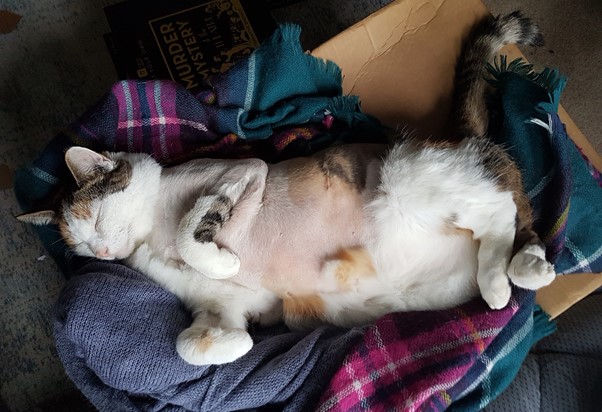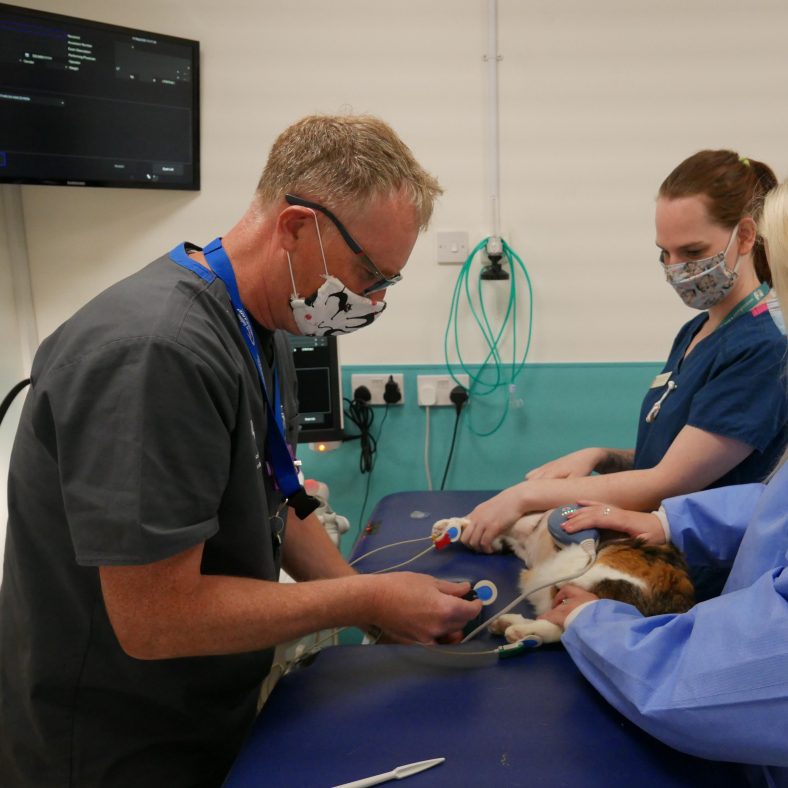Our Community
Rosie’s story

Rosie recovering from her pacemaker surgery at home.
This is the beautiful Rosie, who is our very first feline patient to be fitted with a pacemaker.
Fitting pacemakers in cats is not a common procedure but, with our specialist team of Cardiologists, Soft Tissue Surgeons, and Anaesthetists, Rosie was in good hands.
Rosie had been suffering with frequent tremors and seizure-like episodes so came to meet our Cardiologists, Luca and Heidi Ferasin, to find out what was going on.
Following a thorough examination and a series of diagnostic tests Rosie was diagnosed with a complete atrioventricular block (the interruption of impulse transmission between the different chambers of the heart) with ventricular standstill (where the heart stops beating and stands perfectly still). In Rosie’s case, her heart would stand perfectly still for up to 8 seconds at a time! During these periods Rosie experienced an insufficient amount of blood being pumped around her body by her heart, including a reduced blood supply to the brain, resulting in the neurological signs observed.
As there were not any signs of structural heart disease, the best treatment option for Rosie’s condition is the surgical implantation of a pacemaker.

Rosie during her post-surgery check-up with our Cardiology team members, Luca and Amy.
There are two types of ways to implant a pacemaker in animals: epicardial (surgery is performed by opening the chest) and transvenous (a type of keyhole surgery where the pacemaker is inserted via the jugular vein). Most dogs will have a transvenous pacemaker implantation, with the pacemaker generator (battery) sitting under the skin on the side of the neck and the lead being passed to the inside of the heart via the jugular vein. However, cats are unable to be paced using the same approach and require a surgical procedure. In our feline patients, the pacemaker generator must be placed within the abdominal wall tissues, with the lead attached to the outside of the heart muscle by passing it into the chest cavity through a tunnel in the chest and abdominal wall muscles (epicardial placement on the heart surface).
Because an open-chest approach is required to implant the pacemaker in cats, this type of surgery can carry more risk.
Cardiology specialist Luca said, “Without the multidisciplinary approach of involving surgery and anaesthesia specialists in the procedure, it would be even riskier.”
Our Cardiology team worked closely with our Head of Surgery, Daniella McCready, and our specialist team of anaesthetists, to perform the surgery and place Rosie’s new pacemaker.
Rosie recovered well from surgery and after a couple of days spent recovering in the hospital she was discharged back to her family. Rosie has since been doing very well at home and is enjoying life to the full. Her pacemaker will be inspected every 6 months and re-programmed if necessary.
Thank you for taking the time to read about Rosie’s story.
Take care,
Team Ralph

Hello. My 5-year old cat is in a similar situation and I was wondering how long can cats live with pacemakers. What was Rosie’s outcome?
Hi Christina, this depends on a number of different factors including the underlying heart condition, concomitant diseases, etc. But without complications or comorbidities a cat who has a pacemaker should live a full and long life. We hope you and your cat are doing ok!
My cat had a pacemaker fitted in 2017 at the age of approximately 15, and the pacemaker gave her just over 5 years, so she lived a long lifespan as a result of the surgery.
That’s wonderful!